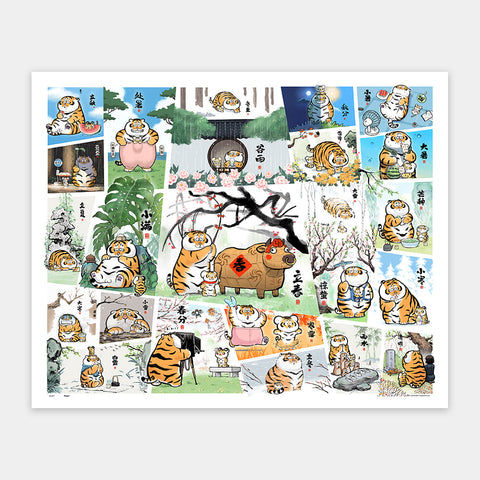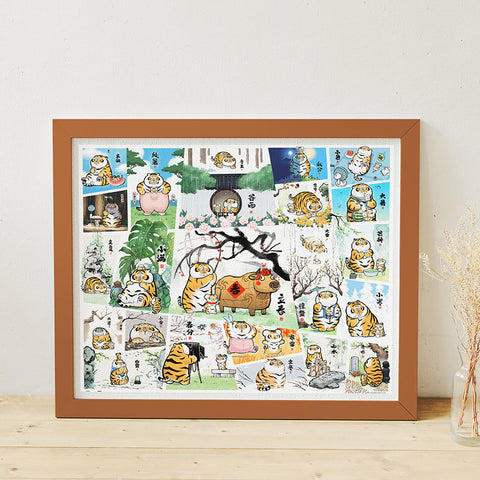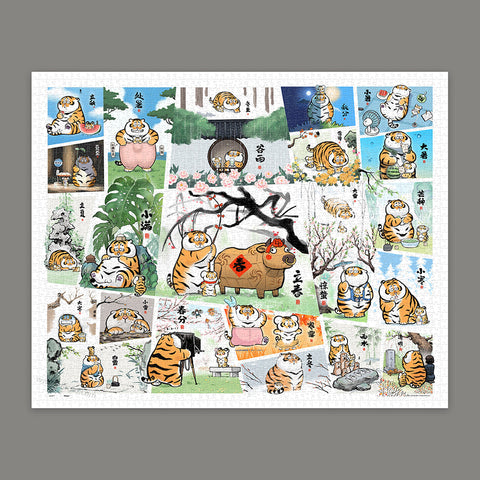



Alexander the Fat Tiger - The 24 Solar Terms
Alexander the Fat Tiger - The 24 Solar Terms
#24节气
Showpiece 2000 Piece Jigsaw Puzzle
Size: 72.8 x 58.8 cm
Code: Pintoo H3267
Available frames: Dark Brown, Cool Gray, Rosewood, Oak, Chestnut, Zephyr
The 24 Solar Terms, known as "节气" (jiéqì) in Chinese, are a traditional East Asian lunisolar calendar system that divides a year into 24 segments. These terms were established in ancient China to guide agricultural activities and daily life according to the solar year's natural changes. Each term corresponds to a specific astronomical event or a significant natural phenomenon, reflecting the changing seasons and climatic conditions throughout the year. Here is a detailed overview:
Spring
- Lìchūn (立春) - Beginning of Spring: Marks the start of spring, indicating the end of winter and the beginning of warmer weather.
- Yǔshuǐ (雨水) - Rain Water: Signifies the arrival of increased rainfall, beneficial for spring planting.
- Jīngzhé (惊蛰) - Awakening of Insects: Warmer temperatures cause insects to emerge from hibernation.
- Chūnfēn (春分) - Spring Equinox: Day and night are of equal length, signifying the midpoint of spring.
- Qīngmíng (清明) - Clear and Bright: Clear and bright weather suitable for outdoor activities, also a traditional time for tomb-sweeping.
- Gǔyǔ (谷雨) - Grain Rain: Rainfall is crucial for the growth of grain crops.
Summer
- Lìxià (立夏) - Beginning of Summer: Marks the start of summer and the onset of hotter weather.
- Xiǎomǎn (小满) - Grain Full: Crops begin to ripen, but are not yet fully mature.
- Mángzhòng (芒种) - Grain in Ear: The time for planting summer crops.
- Xiàzhì (夏至) - Summer Solstice: Longest day of the year, with the most daylight.
- Xiǎoshǔ (小暑) - Minor Heat: Start of the hot period, but temperatures are not at their peak.
- Dàshǔ (大暑) - Major Heat: The hottest period of the year, often associated with heatwaves.
Autumn
- Lìqiū (立秋) - Beginning of Autumn: Marks the start of autumn, signaling the end of summer heat.
- Chǔshǔ (处暑) - Limit of Heat: Heat begins to wane, indicating the approach of cooler weather.
- Báilù (白露) - White Dew: Dew appears as the weather cools down.
- Qiūfēn (秋分) - Autumn Equinox: Day and night are of equal length, marking the midpoint of autumn.
- Hánlù (寒露) - Cold Dew: Dew becomes colder, often turning into frost in some regions.
- Shuāngjiàng (霜降) - Frost Descent: First frost appears, signaling the onset of cold weather.
Winter
- Lìdōng (立冬) - Beginning of Winter: Marks the start of winter and colder temperatures.
- Xiǎoxuě (小雪) - Minor Snow: Light snow begins to fall, but the accumulation is minimal.
- Dàxuě (大雪) - Major Snow: Heavy snowfalls begin, and temperatures drop significantly.
- Dōngzhì (冬至) - Winter Solstice: Shortest day of the year, with the least daylight.
- Xiǎohán (小寒) - Minor Cold: Cold period starts, but not at its peak.
- Dàhán (大寒) - Major Cold: Coldest period of the year, often associated with severe cold weather.
These solar terms have been historically significant in agricultural planning and have also influenced various cultural traditions and festivals in China and other East Asian cultures.
About the product:
- Plastic jigsaw puzzle pieces.
- Water resistant printing.
- Snug interlocking pieces that stay together when picked up.
- Ready to frame when completed.
